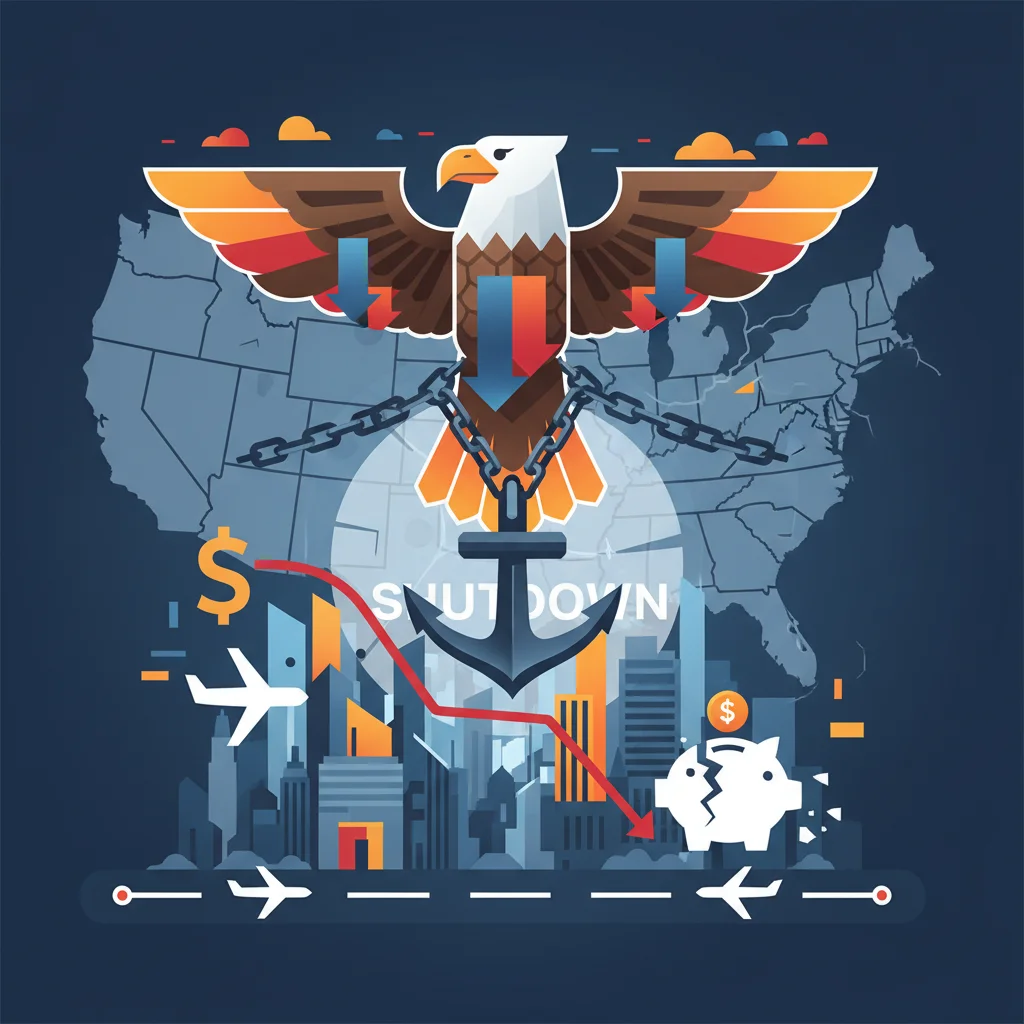
Grounded: How a Government Shutdown Clips the Wings of the US Economy and Your Portfolio
The announcement from Transportation Secretary Sean Duffy was stark and direct: the US will be forced to cut flights by 10% at 40 major airports. The reason? A government shutdown that threatens to compromise the safety and integrity of the nation’s air travel system. While the immediate headlines focus on travel delays and frustrated passengers, the true story is far more complex and has profound implications for the US economy, the stock market, and every investor’s portfolio.
This isn’t merely an administrative issue or a travel inconvenience. It’s a flashing red indicator on the dashboard of the American economic engine. The decision, framed as a necessary measure to maintain safety, stems from the anticipated strain on the Federal Aviation Administration (FAA) and its essential personnel, particularly air traffic controllers. When the government shuts down, these employees are required to work without pay, a situation that inevitably leads to increased stress, higher rates of absenteeism, and potential staffing shortages. As Secretary Duffy noted, these reductions are a proactive step to prevent the system from reaching a breaking point (source).
But the grounded flights are just the most visible symptom of a much deeper economic malaise. This blog post will explore the cascading effects of a government shutdown, moving from the airport tarmac to the trading floors of Wall Street, and explain why this political gridlock matters to business leaders, finance professionals, and individual investors.
The Mechanics of the Shutdown: Why Air Travel is on the Front Line
To understand the economic fallout, we must first grasp the operational mechanics at play. A government shutdown occurs when Congress fails to pass funding legislation, forcing federal agencies to cease non-essential operations. However, services deemed essential for national security, public safety, and health continue to operate, but with a critical caveat: the employees running them do not get paid on time.
Air traffic control is one of the most critical of these essential services. The National Air Traffic Controllers Association (NATCA) has repeatedly warned that forcing its members to work without pay is unsustainable and unsafe. A 2019 report highlighted that during the last major shutdown, the system was pushed to a “breaking point,” with staffing shortages at critical facilities and a significant drop in the number of controllers in training (source). The resulting flight cuts are a direct consequence of this operational strain—a preemptive move to manage a system under duress.
This situation creates a vicious cycle:
- Staffing Shortages: Increased sick leave and a halt in new hiring and training thin the ranks of available controllers.
– Reduced Capacity: With fewer controllers, the FAA must reduce the number of flights that can be safely managed at any given time, leading to delays and cancellations.
– Safety Concerns: While safety is the stated reason for the cuts, the underlying stress and fatigue on the workforce create an environment where risks are inherently elevated.
The impact is not just on passenger flights. Air cargo, the lifeblood of just-in-time supply chains and e-commerce, is also affected. Delays in air freight can halt manufacturing lines, spoil perishable goods, and create logistical nightmares for businesses large and small.
The Trillion-Dollar Question: How a US-South Korea Nuclear Sub Deal Could Reshape Global Investing
The Economic Ripple Effect: A Multi-Billion Dollar Ground Stop
The economic damage from a shutdown extends far beyond the aviation industry. The Congressional Budget Office (CBO) has consistently found that shutdowns inflict real, measurable, and often permanent damage to the US economy. For instance, the 35-day shutdown in late 2018 and early 2019 was estimated to have reduced real GDP by $11 billion, of which $3 billion was permanently lost (source).
This economic drag comes from multiple sources. Furloughed federal workers and unpaid essential employees drastically cut their discretionary spending, impacting local economies around the country. Government contractors face frozen payments, leading to layoffs and stalled projects. The tourism and hospitality sectors, which rely on open national parks and smooth travel, take a direct hit. The flight reductions announced by Secretary Duffy will compound this damage exponentially.
To visualize the widespread impact, consider the various sectors affected by a prolonged disruption to air travel and government services:
| Sector | Primary Impact of Government Shutdown & Flight Reductions |
|---|---|
| Aviation & Aerospace | Direct revenue loss from cancelled flights; delayed aircraft safety inspections and certifications from the FAA. |
| Tourism & Hospitality | Reduced travel leads to lower hotel occupancy, fewer restaurant bookings, and decreased revenue for rental car companies. |
| Retail & Consumer Goods | Decreased consumer confidence and reduced spending by federal workers and those in affected industries. |
| Supply Chain & Logistics | Air cargo delays disrupt manufacturing schedules and delivery of time-sensitive goods, including medical supplies. |
| Government Contracting | Work stoppages and delayed payments create cash flow crises, potentially leading to layoffs and business failures. |
This interconnectedness means that no corner of the finance world is truly immune. The uncertainty spooks markets, depresses consumer sentiment, and complicates corporate planning and investment decisions.
The Billion AI Gamble: Are Tech Giants Building the Future or a Bubble?
Navigating the Turbulence: A Guide for Investors
For investors, a government shutdown introduces a significant dose of market volatility. While history shows that the broader stock market tends to be resilient to shutdowns over the long term, the short-term picture can be choppy and sector-specific impacts can be severe. A study by LPL Financial found that during 21 historical shutdowns, the S&P 500’s median return was 0.0% (source), suggesting market paralysis rather than outright panic.
However, savvy investors must look beyond the headline index. The announcement of flight cuts immediately puts airline and travel-related stocks under pressure. Companies like major carriers, hotel chains, and online travel agencies will face downward earnings revisions if the disruption is prolonged. Defensive positioning becomes key.
Here are some strategic considerations for investing during such periods:
- Sector Analysis: Identify sectors most at risk (Airlines, Travel, Leisure, some Government Contractors) and those that may be more insulated (Consumer Staples, Utilities, Healthcare).
- Focus on Quality: In times of uncertainty, capital tends to flow towards companies with strong balance sheets, consistent cash flow, and low debt. These businesses are better equipped to weather economic storms.
- Avoid Panic Trading: Emotional, knee-jerk reactions are an investor’s worst enemy. A shutdown is a political event, not necessarily a fundamental shift in the long-term value of a well-run company.
- Look for Opportunities: Market overreactions can create buying opportunities in solid companies that are unfairly punished by broad-based selling.
The core principles of sound economics and long-term investing—diversification, due diligence, and a focus on fundamentals—become more important than ever when Washington D.C. introduces chaos into the financial system.
Can Technology Offer a Solution? The Role of Fintech and Blockchain
While the root of a shutdown is political, it exposes operational and financial fragilities that technology could help address. This is where forward-thinking concepts from the worlds of financial technology and blockchain enter the conversation.
Consider the immediate financial hardship faced by hundreds of thousands of federal workers. Fintech platforms are already stepping in to fill the gaps left by traditional banking. Earned wage access apps, low-interest micro-lending platforms, and automated financial planning tools can provide a crucial lifeline for families whose income suddenly drops to zero. This represents a real-world stress test for a fintech ecosystem built on the promise of providing more flexible and responsive financial services.
Looking further ahead, one can speculate on the role of more advanced technologies like blockchain. Imagine a future where essential government functions are funded via smart contracts on a blockchain. These contracts could be pre-programmed to automatically release funds for critical services like air traffic control as long as certain operational conditions are met, creating a system that is insulated from short-term political disputes. While this is a futuristic concept, the current crisis highlights the need for systems that prioritize operational continuity. The same technology could be applied to supply chains, providing greater transparency and traceability for critical goods when traditional logistics channels like air freight are disrupted.
The Apple Tax on Trial: How a UK Ruling Could Redefine Big Tech's Financial Power
Conclusion: The High Cost of Gridlock
The 10% cut in flights across 40 US airports is more than a travel headache; it’s a stark visualization of the real-world consequences of political dysfunction. It shows how quickly gridlock in Washington can cascade into tangible economic damage, disrupting industries, shaking investor confidence, and impacting the daily lives of millions.
For investors and business leaders, the key takeaway is the rising importance of political risk in any analysis of the US economy. The shutdown underscores the fragility of the systems we rely on and serves as a reminder that market stability is intrinsically linked to functional governance. While the immediate focus will be on navigating the market volatility and operational challenges, the longer-term question is how to build more resilient economic and financial systems that can withstand the turbulence of our political climate.


